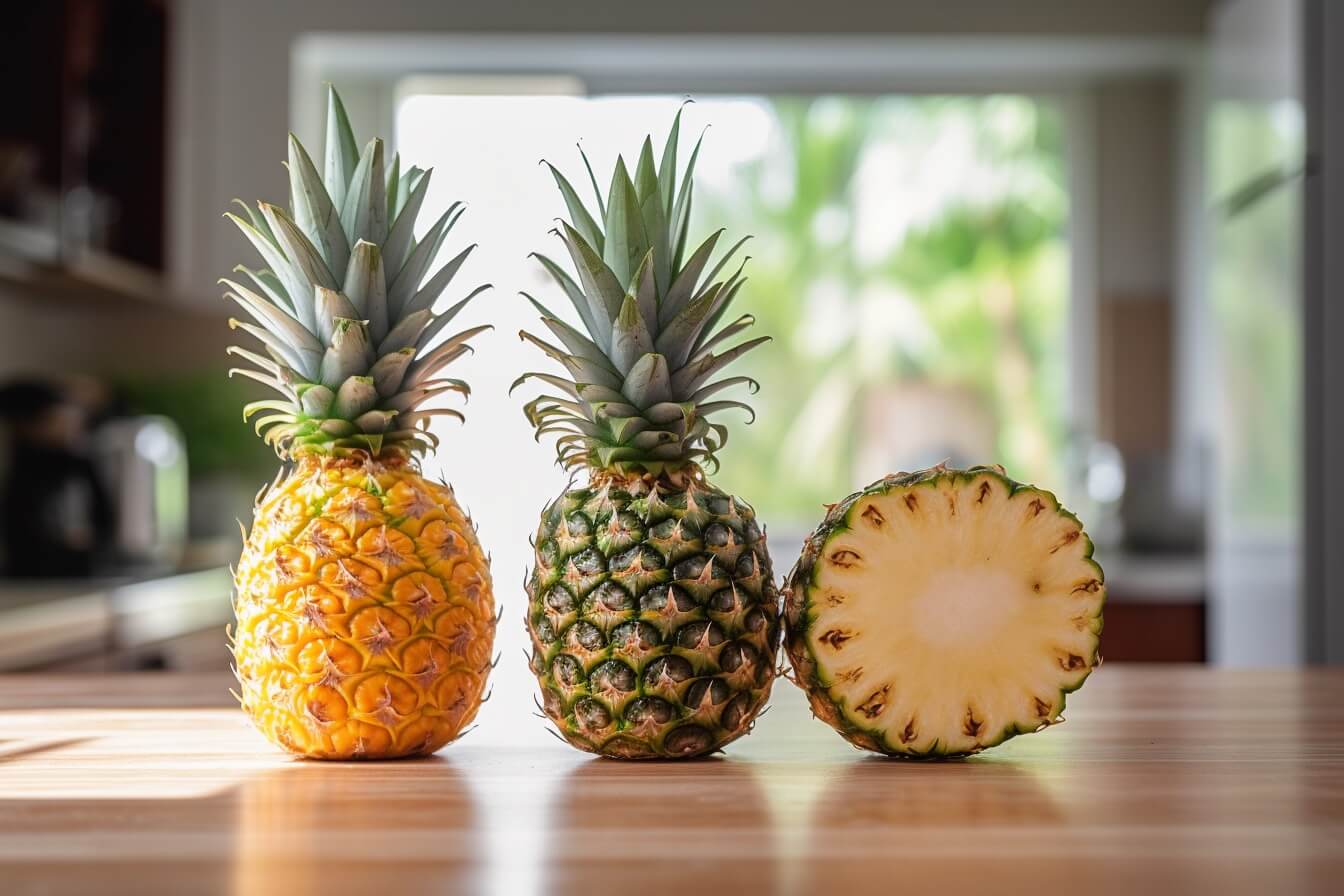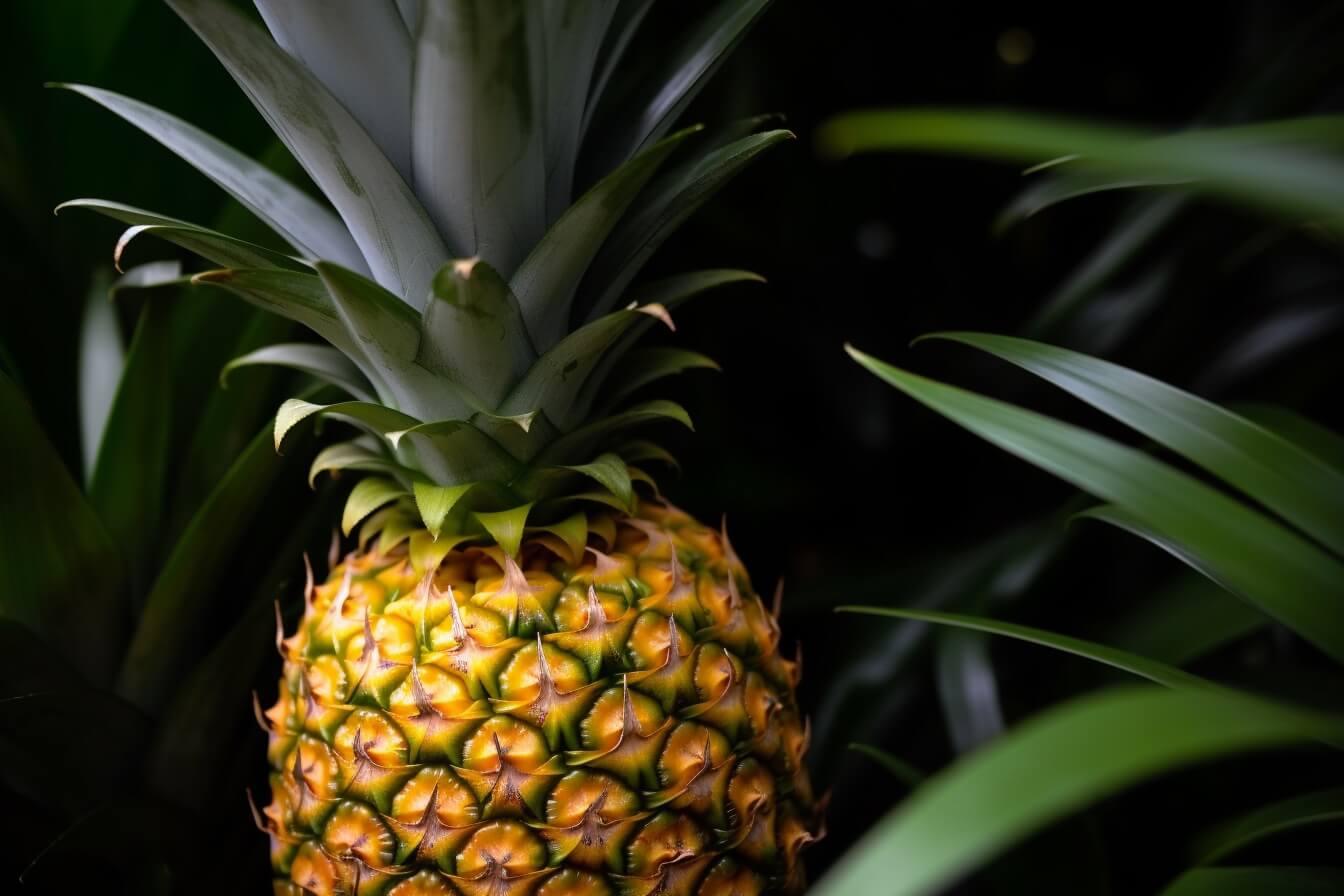Pineapples can sometimes develop small black seeds beneath their skin, however, not all fruits will have these seeds.
Pineapples, the spiky and sweet tropical fruit native to South America, can indeed produce seeds. However, it’s fairly uncommon for the average grocery store pineapple to contain these tiny black seeds, as explained in article by the Botanical Research Institute of Texas.
When they do appear, you’ll find them hiding just beneath the surface of the pineapple’s tough skin.
The presence of black or dark brown seeds in some pineapples is due to natural pollination that occurs as insects such as bees visit individual flowers on pineapple plants.

Locating Pineapple Seeds
Locating pineapple seeds in the fruit can be a bit tricky. These elusive seeds are typically found nestled within the eyes or fruitlets of a ripe pineapple.
When searching for pineapple seeds, I’ve found that it’s best to examine these individual sections of the fruit closely.
If you happen to find a pineapple with small black or brown seeds, gently remove them using a pair of tweezers or the tip of a knife. For seed enthusiasts seeking to try their hand at growing this tropical plant, locating viable seeds is just the first step of an exciting journey into cultivating your own Ananas comosus (Morton, 1987).
Why Some Pineapples Don’t Have Seeds
You may be surprised to learn that most commercial pineapple varieties are seedless. This isn’t a natural occurrence but rather the result of careful genetic modifications and hybridization by cultivators over the years.
This absence of seeds in popular pineapple varieties can be attributed to their “self-incompatibility.” Essentially, this means that the plants are unable to fertilize their own flowers, preventing them from producing seeds.
However, pineapples have developed mechanisms that allow them to produce fruit even without being pollinated or generating seeds – a phenomenon known as parthenocarpy (Bartholomew et al., 2012).
In contrast, research from the University of Costa Rica shows that wild pineapples contain approximately 50 seeds per fruit. In their native environments such as South America and Costa Rica, these fruits rely on traditional methods of reproduction through pollination by insects or other animals; thus allowing for genetic diversity among plant populations.

How Do Pineapples Reproduce Without Seeds
Most varieties of pineapple are seedless, which means they cannot produce seeds through sexual reproduction. Instead, pineapples can reproduce asexually through vegetative propagation or cloning (Crane et al., 2006).
This process involves taking the offspring from the central stem of parent plants and growing them into new plants.
Pineapple growers often use vegetative propagation because it ensures that the fruit grows true to its parent plant’s characteristics since there is no genetic variation in cloned plants.
In summary, pineapples rarely reproduce sexually but instead grow through cloning techniques.
Is It Safe To Eat Pineapple Seeds?
Yes, it is completely safe to eat pineapple seeds. In fact, many people consume them without even realizing it! Pineapple seeds are not toxic to humans and can be eaten raw or cooked, according to Drugs.com.
However, they do have a tough outer layer that may not be very pleasant to bite into. If you want to try eating pineapple seeds, you can remove the outer layer by soaking the seeds in water for several hours or overnight.
Not only are pineapple seeds safe to eat, but they also contain some health benefits. They are rich in fiber and contain small amounts of vitamins and minerals such as calcium and iron, according to USDA.
Overall, there’s no need to worry about consuming pineapple seeds – they’re perfectly fine! And if you don’t like the taste or texture of the seeds themselves, you can always plant them instead and grow your own pineapple plant at home.
Can You Grow Pineapple From A Seed?
Yes, it is possible to grow a pineapple from a seed, but it requires some patience and effort, as I’ve discovered.
- To start with, you will need a ripe pineapple fruit containing seeds that are viable.
- After removing the top of the fruit and taking out the flesh, gently clean away any remaining residue to reveal brown seeds hiding underneath.
- Once you have the seeds ready, place them on a damp paper towel in a warm place until they germinate into tiny plants.
- You can then transfer these sprouts into pots filled with potting soil, ensuring that only their top parts stick above ground level.
Research from the Department of Agriculture of the University of Florida recommends providing full sun with temperatures between 68°F and 86°F (20-30°C), along with 70-80 percent humidity.
It typically takes two years or more for pineapples grown from seedlings to produce fruit due to its long vegetative propagation stages.
